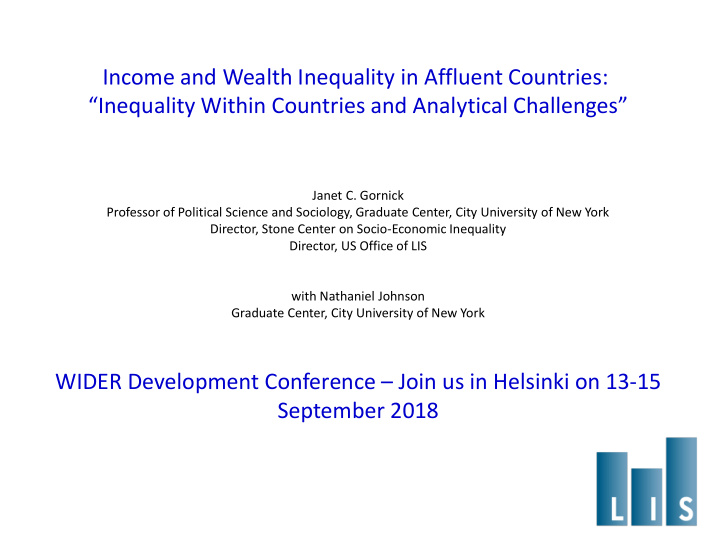



Income and Wealth Inequality in Affluent Countries: “Inequality Within Countries and Analytical Challenges” Janet C. Gornick Professor of Political Science and Sociology, Graduate Center, City University of New York Director, Stone Center on Socio-Economic Inequality Director, US Office of LIS with Nathaniel Johnson Graduate Center, City University of New York WIDER Development Conference – Join us in Helsinki on 13-15 September 2018
Introduction to LIS – an institution and a database Empirical snapshot 1 – income inequality in high-income countries Empirical snapshot 2 – the middle of the income distribution Empirical snapshot 3 – incorporating middle-income countries Empirical snapshot 4 – wealth inequality (time permitting) Analytical Challenges at LIS
Introduction to LIS LIS (“Cross - National Data Center in Luxembourg”) is a provider of cross-national, over- time, microdata (i.e., households and persons). Currently covers about 50 countries, mostly high- and upper-middle income, organized into 10 repeated cross-sections (“waves”), from 1980 -2016. LIS ’ main value added: (1) labor-intensive work of data harmonization. (2) remote-execution system enables access to eligible researchers from universities, government agencies, and NGOs. Primary focus is income data; also labor market, consumption, wealth variables. Venue for teaching, training, research-sharing (Working Papers, conferences), and development of methodological standards; large virtual research community. History of collaboration with supranational organizations, including OECD, World Bank, IMF, ILO, and several UN agencies. And, of course, LIS has long been a data source for WIID, WIDER’s World Income Inequality Database.
Question 1 It has been widely reported that, since the 1980s, income inequality has increased in about 2/3 of high-income countries. Is that accurate? Has market income inequality increased? Disposable income inequality? Both?
Household income inequality, non-elderly households 2013 (except Australia and Ireland – from 2010) Market income and disposable income (DHI), Ginis Data source: LIS Database
Market income and redistribution, non-elderly households 2013 (except Australia and Ireland – from 2010) Data source: LIS Database
Market income and disposable income (DHI), Ginis, non-elderly households – change, approx. 1985 to approx. 2013 Data source: LIS Database
Question 2 We hear a lot about “the hollowing out of the middle”. During the last three decades, what exactly has taken place in the middle of the income distribution? Has the size of “the middle” – defined by percentage deviations from the median – shrunk? Has the real income level of the middle fallen?
Households with disposable income between half and twice the median, non-elderly households – percentage point change, approx. 1985 to approx. 2013 Data source: LIS Database
“Where have they gone?” – up or down? percentage point change, approx. 1985 to approx. 2013 Data source: LIS Database
Disposable income (DHI) levels, non-elderly households – approx.1985 to approx. 2013; 10 th , 25 th , 50 th , 75 th , and 90 th percentiles Data source: LIS Database
Question 3 How do contemporary patterns of income inequality differ between high- and middle- income countries?
Household income inequality, non-elderly households 2013 (except Australia and Ireland -2010, Israel, South Africa, South Korea – 2012, Guatemala – 2014) Market income and disposable income (DHI), Ginis Data source: LIS Database
Disposable income, non-elderly households, 2013 % of households < 50% median, 50-200% median, 200%+ median Data source: LIS Database
Disposable income levels, non-elderly households, 2013 International dollars, 10 th percentile, 90 th percentile Data source: LIS Database
Question 4 What do we know about the distribution of wealth across households in high-income countries, after the crisis? To what extent are income and wealth jointly distributed across households?
Income and wealth Ginis, 2010-2014 period (households with non-elderly heads) INCOME GINI WEALTH GINI Australia 2010 0.318 0.629 Canada 2012 0.336 0.690 Finland 2013 0.256 0.643 Italy 2014 0.329 0.599 United Kingdom 2011 0.355 0.641 United States 2013 0.473 0.878 Data source (both income and wealth results): LWS Database. Wealth is disposable net worth, which is household non-financial and financial assets (excluding pensions) minus all liabilities
Income and wealth shares, 2010-2014 period (income in the income distribution, wealth in the wealth distribution) (households with non-elderly heads)
Income and wealth inequality, 2010-2014 period - joint distribution (households with non-elderly heads) Data source: LWS Database
LIS: Cross-National Data Center in Luxembourg. Producing harmonized cross-national income/wealth microdata - analytical and other challenges ● Selecting countries and datasets: Cross-national comparability (fewer) versus global coverage (more) Hard-to-acquire priorities versus easily-available datasets ● Assessing data quality (when is a dataset good enough to include?): What is the minimum “signal -to- noise ratio”? ● Editing datasets and/or imputing missing data: Are we a data creator or a data custodian? ● Designing scope of variable list and level of variable disaggregation: Detail versus user-friendliness More information per dataset versus more datasets ● Constructing documentation: Balancing back-end investment with front-end needs ● Moving beyond income and/or beyond household surveys: Constancy versus change
Thank You Janet C. Gornick Director, Stone Center on Socio-Economic Inequality Director, US Office of LIS
Recommend
More recommend